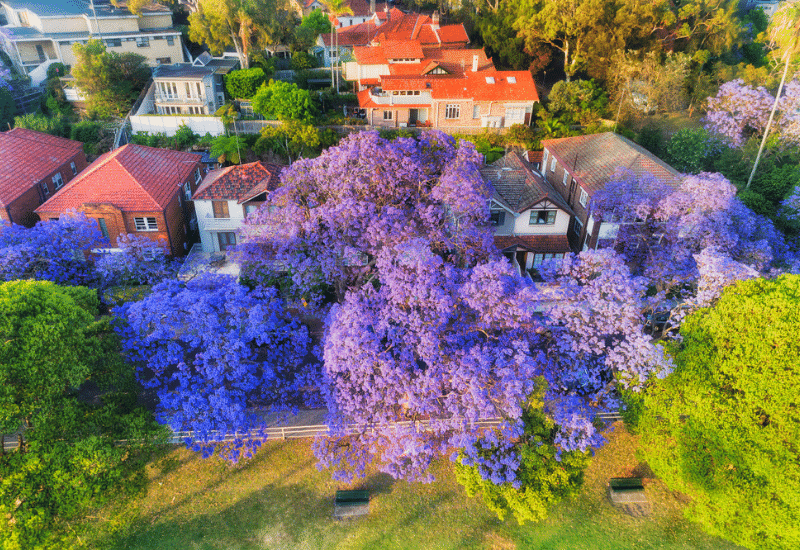
Does your garden need a touch of vibrant intensity and depth? Then tress that offers white spring flowers are great for adding richness, and a pop of color to your garden, and many are known for their fragrant blooms.
And purple is one of the most intense colors ever: ranging from light lilac to deep violet, it will add an emotional dimension to your design.
From popular magnolias to refined jacaranda, there are many flowering trees that blooms within this spectrum that can literally make your jaw drop.
In choosing your purple blooming newcomer to your green haven, you need to consider the exact shade, the shape of the flowers, foliage and size.
Then again, there are purple flowering trees that will grow well in your area, others that won’t.
But after reading, you will have a clear idea and surely find these purple blooming tree to be excellent additions to inject this special color to your garden.
And after a few short words on why purple is special in any garden, I will demonstrate to you why they are the very best! so stay with us…
The Color Purple in Flowers and Trees
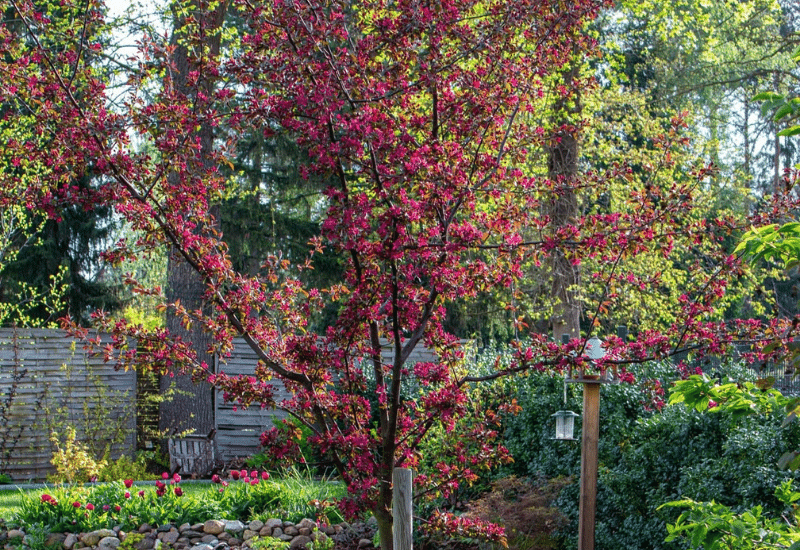
We said that purple is a very special color; it is strong, to start with, full of energy and vibrant.
It adds “class” to any palette, and once it was the rarest in clothes and paintings, because the pigment you needed was literally the most expensive in the world.
But leaving its social history apart, purple is also a healing color, and very much linked to spirituality. And what better than having it with Nature and flowers on the canopies of trees?
From an emotional point of view, light purple brings a sense of peace and light heartedness; dark shades give you emotional depth. It is also connected with imagination and wisdom.
You can have all this in your garden, and I promise you, the trees you are going to see are just fantastic.
12 Most Beautiful Purple flowering trees to Plant in Your Garden
Here are 12 stunning trees with purple flowers to add beautiful hues to your landscape.
1:Green Ebony Tree (Jacaranda mimosifolia)
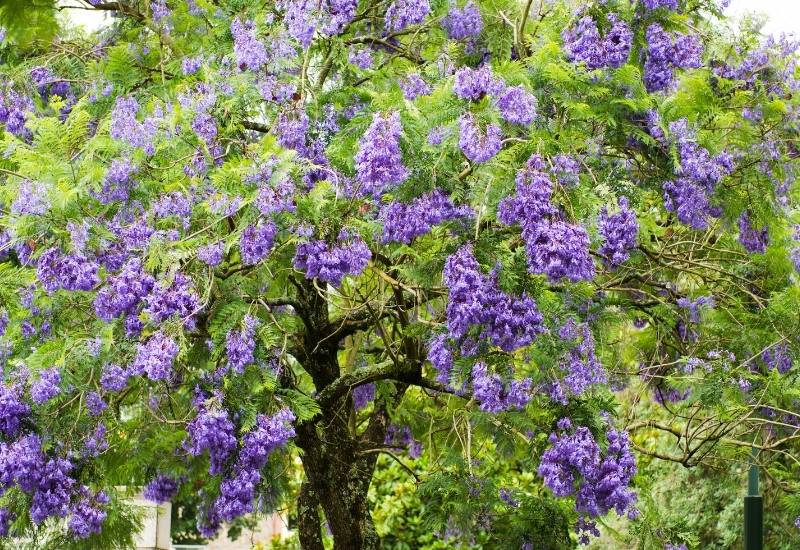
Green ebony tree, often called with its Latina name, jacaranda, is an elegant and spectacular medium sized deciduous tree for warm climates.
Form late sprung, it will come out with a massive bloom of clusters of lavender violet flowers that remind me of those of wisteria.
It will do so when the leaves are just starting… When they grow, you will love the finely segmented mid green foliage, with an exquisite texture, like that of mimosa.
The trunk is upright and straight, and the branches very elegant, forming a round crown that gives you dappled shade all through the warm months.
It is a worthy receiver of the Award of Garden Merit by the Royal Horticultural Society.
The elegance and vibrancy of green ebony tree can lift any garden, and when it’s in bloom it can literally become a marvel of Nature.
It is ideal for specimen planting, because jacaranda is a protagonist with no match! It is ideal for Mediterranean style designs.
2:Chaste Tree (Vitex agnus-cactus)
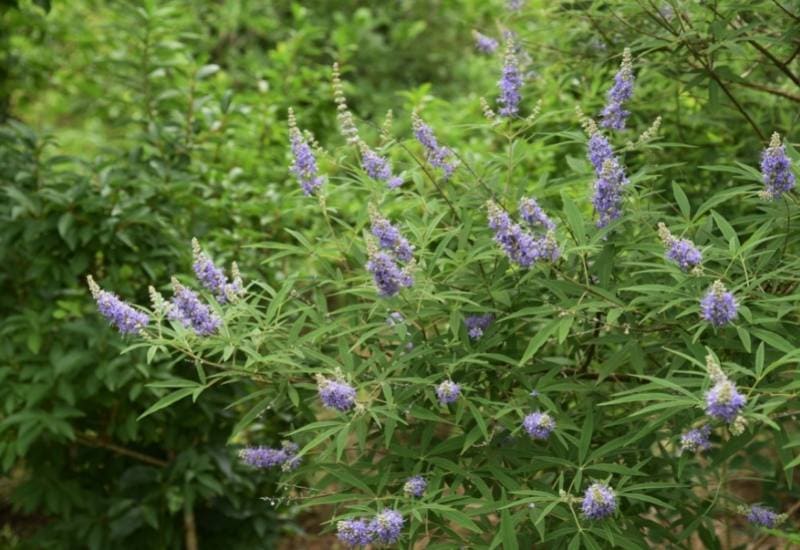
Chaste tree is a deciduous shrub or tree with generous violet blooms. These come in spikes that point out and up from the foliage and each can be 12 inches long (30 cm).
They are fragrant and they can last through the hot season, when they fill with butterflies and pollinators.
The foliage is dense, gray green and each leaf is made up of 7 elegant elliptical sections arranged in a fan shape.
It is vigorous and fast growing, but if you leave i to its own devices, it will stay a shrub; train it into a small tree with appropriate pruning when young.
It is a winner of the Gold Medal Award by the Pennsylvania Horticultural Society.
Grow it as a specimen plant as a tree, or if you want, it adapts to foundation planting and even hedges, as long as your garden has an informal design. Once trained, it is a low maintenance plant.
3:Texas Mountain Laurel (Sophora secundiflora)
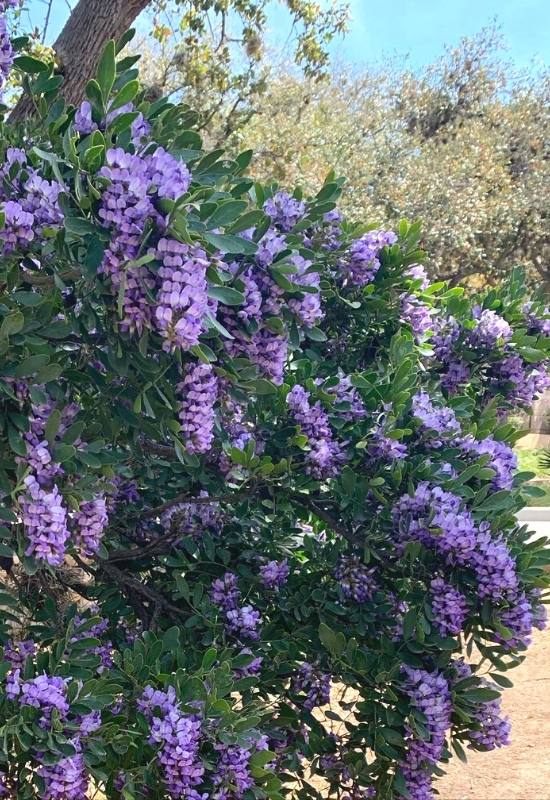
Texas mountain laurel is an evergreen shrub or tree which grows slow and it will fit its purple blue flowers in small gardens.
They come in thick clusters of very fragrant blooms, with an original aroma of bubble gum mixed with soda and attract lots of pollinators.
They are followed by decorative off white fuzzy pods that ripen into light brown and shed their coat.
The foliage is leathery, pinnate and mid to olive green in color. It is a very original looking low maintenance shrub which is easy to train into a small tree.
Texas mountain laurel is a tough tree you can have in informal garden as specimen planting or foundation planting, but as a shrub it will suit borders and hedges too. It adapts to coastal gardens too.
4: ‘Purple Robe’ Black Locust Tree (Robinia pseudoacacia ‘Purple Robe’)
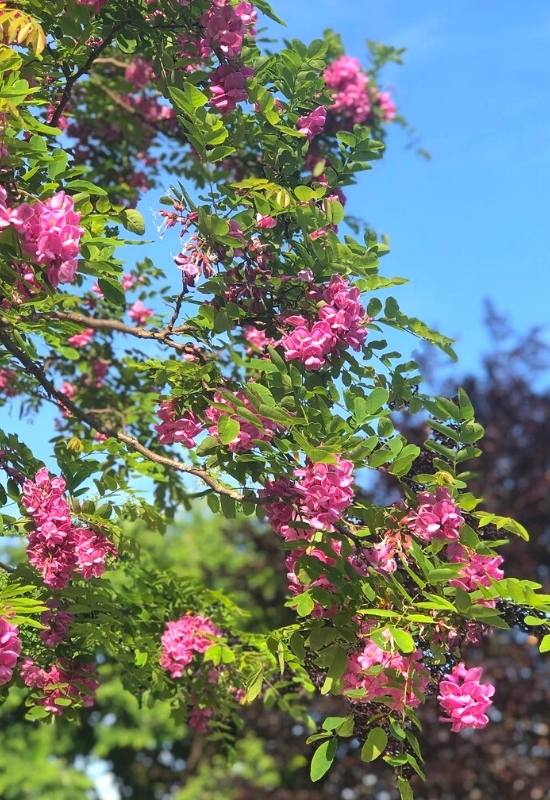
‘Purple Robe’ is a cultivar of the deciduous black locus tree selected for the bright magenta purple shade of its flowers.
The original plant has white ones, and both have fragrant and long pendulous racemes of pea like flowers that can reach 8 inches (20 cm), and they come abundantly all over the branches in spring, attracting pollinators and hummingbirds.
The beautiful pinnate foliage will give you shade and texture till frost, while long brown purple pods will appear among the canopy after the blooming season, and stay on for months. It is also a favorite nesting place for many species of birds!
‘Purple Robe’ black locust is a cold hardy specimen plant for informal gardens, but also in clumps it can give you fresh and shady areas, excellent for a naturalized area.
5: Desert Willow (Chilopsis linearis)
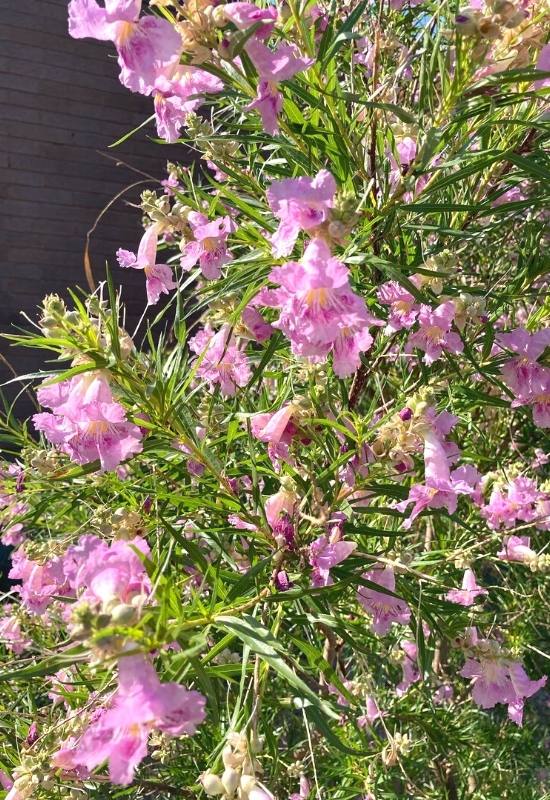
Desert willow is an elegant deciduous shrub or small tree with showy and exotic looking blooms.
They have a lighter lilac shade on the outside, while the inside will be strong magenta to pink purple, with bright saffron yellow pistils.
They come with their fragrance at the end of branches and they look lie wide and colorful frilled trumpets.
They are followed by lots of long pods that can reach 10 inches (25 cm), while the foliage is ling, elliptical, leathery and mid green, fairly loose on the branches.
This way, the crown acquires a very intricate texture with lovely games of light and shade.
Desert willow is ideal for a dry looking garden, alone or in clumps; a courtyard, gravel or Mediterranean design would be ideal. It is tough and low maintenance and easy to train into a tree.
6: ‘Ace of Hearts’ Eastern Redbud (Cercis canadensis ‘Ace of Hearts’)
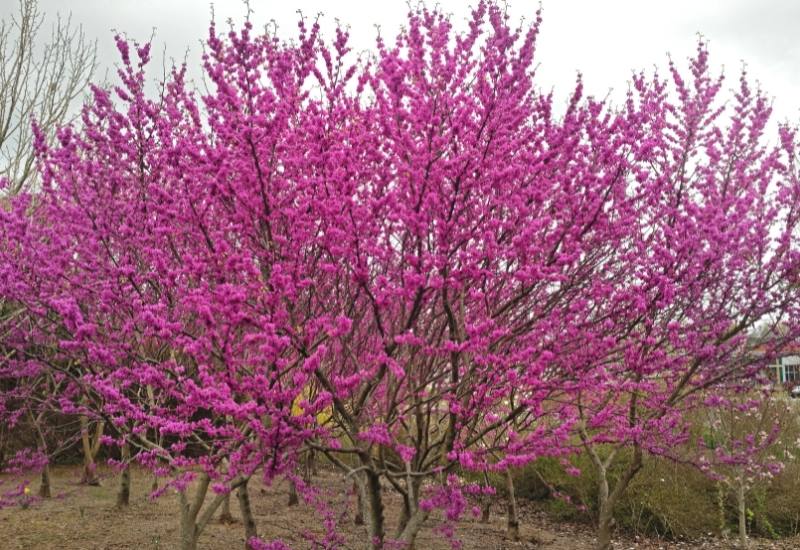
‘Ace of Hearts’ is a small deciduous trees with epic purple blooms that you can fit even into a small space.
The numerous light to intense magenta flowers will cover the leafless branches in early spring, giving you a “cherry blossom” effect.
The crown has a naturally round shape, which adds to the dramatic effect. When the leaves come, this small beauty will give you another spectacle!
Regularly placed along the branches, they are large and heart shaped, mid green till fall, when they turn yellow for a last blush.
‘Ace of Hearts’ is a great asset as a showy specimen plant or even inside borders in most informal designs, especially cottage gardens and traditionally inspired ones.
7: Princess Tree (Paulownia tomentosa)
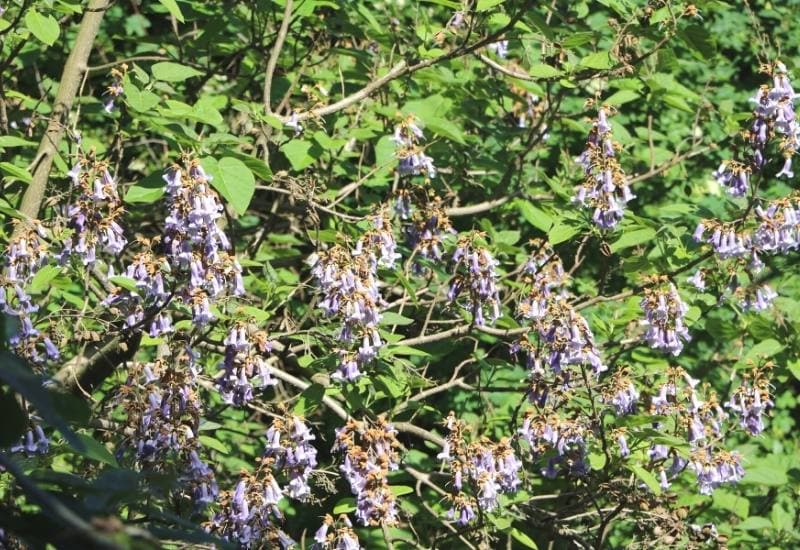
Princess tree, or empress tree is a super fast growing tree with fragrant light purple blooms.
They will come in panicles before the leaves appear on the branches, tubular in shape and up to 2 ¼ inches long (6.0 cm).
They look like foxglove, and in fact it is also called foxglove tree… They will be followed by capsules that ripen among the foliage.
But you won’t see much, because the leaves are huge! They can be anything between 6 and 16 inches across (15 to 40 cm!), mid green and with five lobes.
It is becoming a very popular tree for its wood, thanks to the fact that it can grow up to 12 feet (3.6 meters) in a single year!
In gardening, the beautiful blossom and decorative foliage make it a promise for the future.
Princess tree is perfect for quick results in informal gardens. You can get shade and structure in a short time and with little effort but plenty of water if you grow it as a specimen tree or in groups for large spaces. Ideal for public parks.
8: ‘Royal Purple’ Smoke Tree (Cotinus coggyria ‘Royal Purple’)
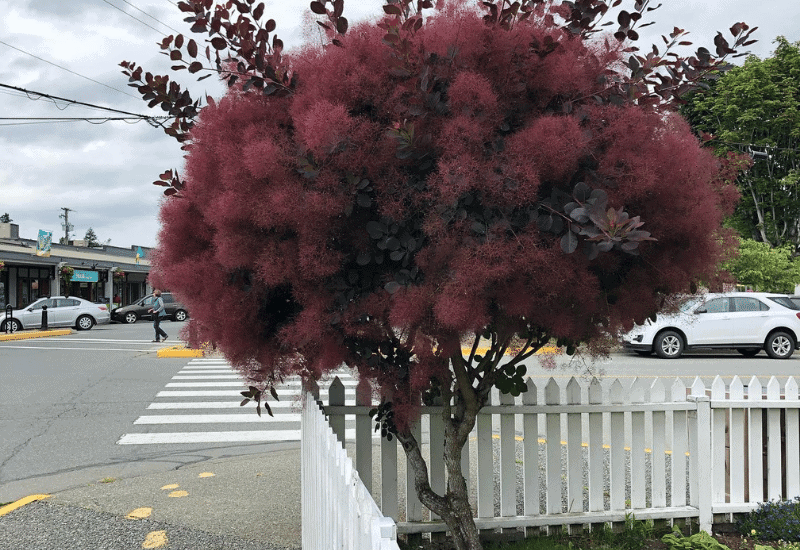
The name of this smoke tree variety is really spot on: it has purple leaves and purple blooms! But of different shades…
The original inflorescences look like round and large clouds of smoke pink purple fluffs that come in summer.
The foliage, on the other hand, id of a deep burgundy tint, which offers a harmonic but varied effect when in bloom.
It has a large and thick crown that will take on a round or oval shape, larger across than from top to bottom. Each leaf is broad, veined and very regular in shape.
‘Royal Purple’ smoke is ideal to bring depth and warmth from spring to frost in garden. It can lift any green space with its striking color.
It looks good in most informal gardens, even in a Japanese one, as a specimen plant.
9: ‘Andenken an Ludwig Spath’ Lilac (Syringa vulgaris ‘Andenken an Ludwig Spath’)
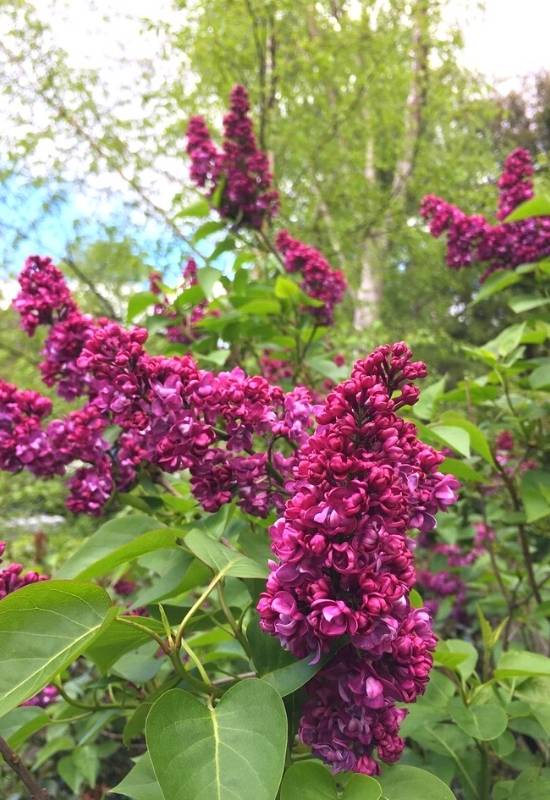
You can train lilac shrubs into small trees, and the most impressive purple cultivar is ‘Andenken an Ludwig Spath’. With its long panicles that reach 12 inches (30 cm) packed with super fragrant deep wine purple flowers it is lush,
luxurious and the most decidedly purple variety you can find. The eye catching and reliable blossom will last for about one month, and then you will still enjoy the dense,
heart shaped leaves and their dark green shade. It has a naturally upright habit, so it’s easy to turn it into a tree with basic pruning.
Since its introduction in 1883, it has received the Award of Garden Merit by the Royal Horticultural Society.
‘Andenken an Ludwig Spath’ lilac can grow in borders or as a small specimen tree in any informal garden, and it will literally wow your visitors with the intense coloring of its amazing blooms.
10: Hong Kong Orchid Tree (Bauhinia x blakeana)
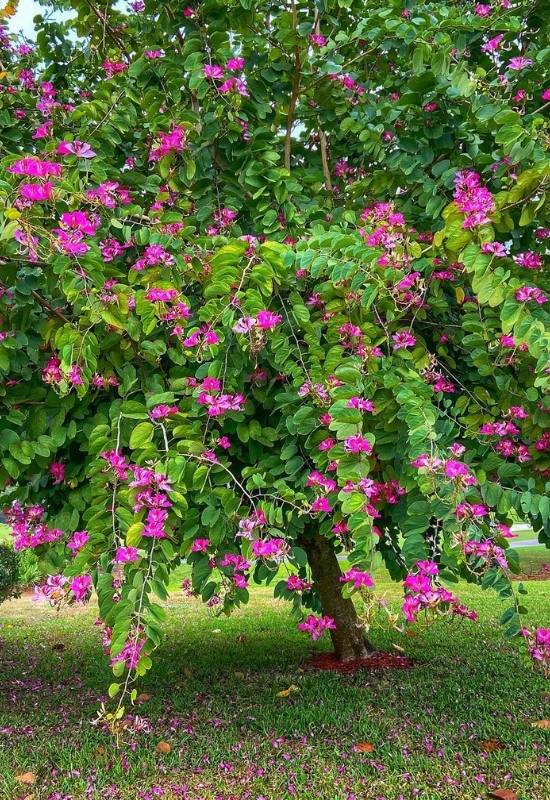
Hong Kong orchid tree is exotic looking and very decorative, with showy deep magenta purple flowers.
Each bloom can be 6 inches across (15 cm) and it has 5 petals with lighter dashes towards the middle.
They are very eye catching, and a real spectacle, especially when humming birds come to visit them, because they love them!
The broad leaves have two wide lobes, and they start off in shades of copper to turn mid and dark green later on; they are about 8 inches wide (20 cm)!
Most of the leaves, but not all, will drop, but only when in bloom! They will do so when the tree is in bloom. It will also offer you decorative pods that hang from the branches in summer.
Hong Kong orchid tree is a spectacular choice for most garden designs, including exotic and oriental ones, but not just!
As a specimen plant, of course, because its long lasting blooms want to be admired!
11: ‘Royalty’ Crabapple (Malus ‘Royalty’)
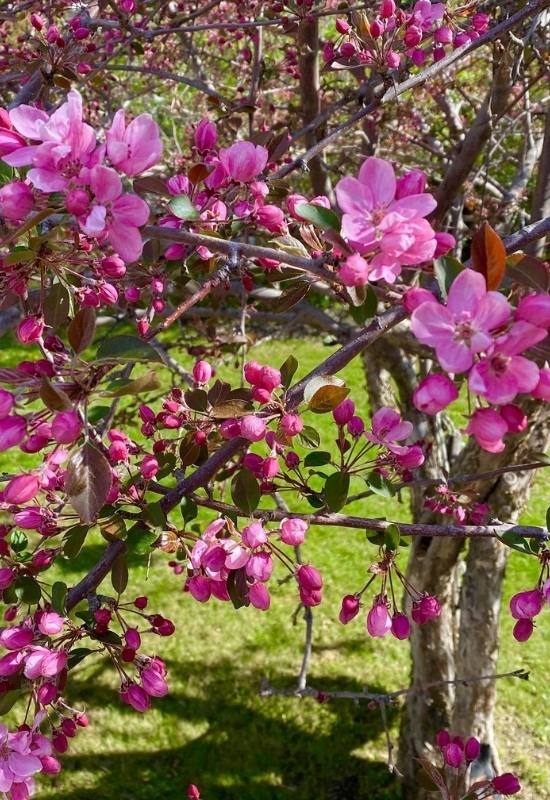
‘Royalty’ is an extraordinary variety of crabapple with a purple theme, and not just in its blooms.
The five petaled flowers that appear in large profusion in spring are in fact of a rich, full and intense cardinal purple shade.
They will cover the branches when the leaves are still small. You will already notice that the foliage is variegated, with dark green leaves showing copper undersides,
but many will take on old mauve purple dashes, and quite a few will be totally of an intense shade of this unusual color The dark red fruits that look like cherries that follow will complete the amazing color display of this cold hardy apple tree.
Grow ‘Royalty’ crabapple for an original touch with a traditional tree in a natural looking, informal garden like a cottage garden or English country garden. It will adapt to other designs, better used as a specimen plant.
12: ‘Genie’ Magnolia (Magnolia ‘Genie’)
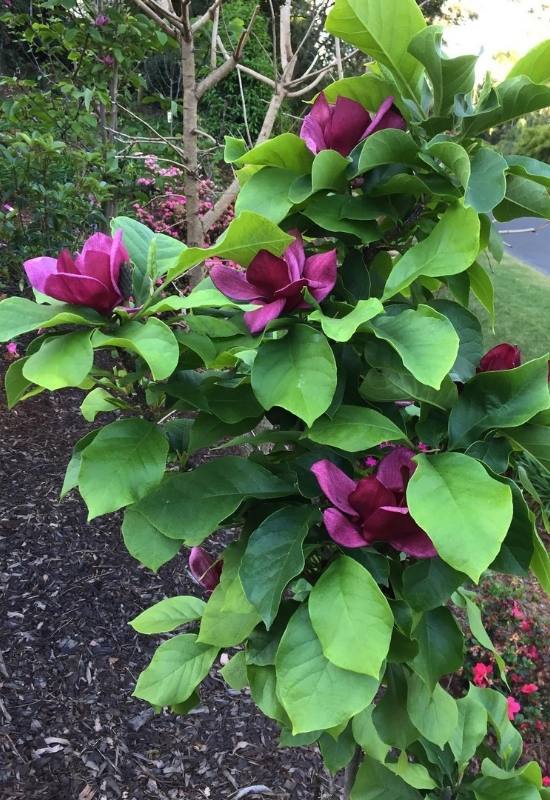
There are a few magnolia varieties with purple flowers, but none lite the small ‘Genie’. The buds are dark red, but as they open, you will have an explosion of perfect maroon 4 purple, the darkest and richest hue in this shade.
It is an almost impossible color to find! The lovely cupped flowers are about 6 inches across (15 cm), showy and very fragrant too.
The spectacle on the bare branches is almost surreal. When the glossy oval leaves come, leathery and shiny, you will have dark green over sides and an echo of the purple bloom of spring on the undersides.
‘Genie’ is a prized but small cultivar of magnolia, ideal for small spaces thanks to its size,
it will look great as a specimen plant in most informal gardens, ranging from urban and gravel designs to Japanese gardens and traditional ones.
Purple Flowering Trees: a Prized Presence in Any Garden
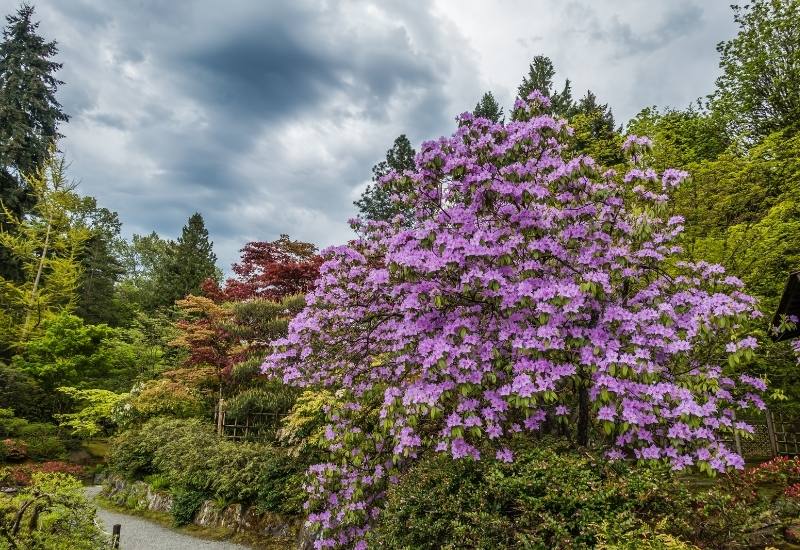
You never thought there would be so many beautiful purple flowering trees, did you? This very special color is not very common at all, but you have just met the most beautiful trees with purple flowers you can ever grow! What an amazing spectacle!

Written By
Adriano Bulla
After many years as an academic in London, Adriano Bulla became a writer, publishing books like A History of Gardening, Organic Gardening and Elements of Garden Design; he then decided to become a gardener, following his childhood dream, and has been following his dream writing and gardening professionally in Southern Europe, where he has specialized in new and innovative organic gardening fields and techniques, like permaculture, regenerative agriculture, food forests and hydroponics.

I LOVE THIS TREE, BUT WIL IT GROW IN ZONE 10? SEBASTIAN, FLORIDA 32958
Not all are suitable to grow in your place but some will obviously.